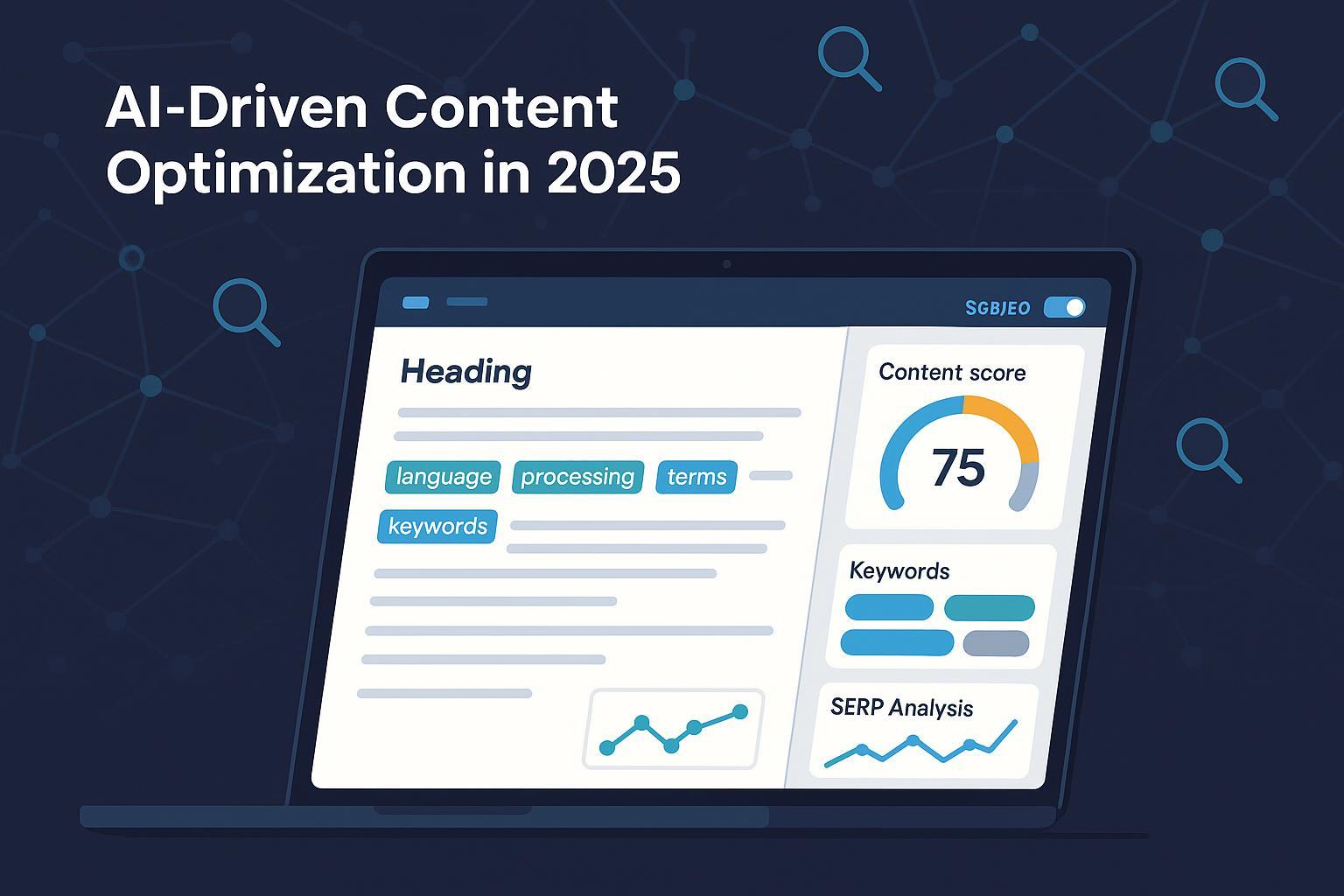Top AI Content Optimization Tools That Actually Work in 2025

If you’re planning your 2025 content stack, the biggest question isn’t “Which AI tool is flashiest?” It’s “Which tools actually improve search visibility and ship better drafts faster—without breaking my budget or workflow?” This roundup prioritizes tools that consistently help teams create outlines, cover topics deeply, and optimize pages with verifiable guardrails (NLP terms, briefs, SERP analysis, internal link cues).
Note on pricing: We list “from” prices to reflect entry tiers where relevant. Prices and inclusions change frequently—always confirm on vendor pages.
How we chose (methodology)
We evaluated tools using a transparent rubric (weights in parentheses):
- Capability match to AI optimization (briefs, NLP scoring, topical coverage, AEO/SGE support) — 30%
- Workflow & integrations (Docs, WordPress, CMS, extensions) — 20%
- Learning curve & team readiness — 15%
- Evidence strength & reliability (third‑party tests, update cadence) — 15%
- Value for money (per seat/report, credit limits) — 20%
We also looked at how tools support quality and trust signals. For a deeper dive into content quality scoring and E‑E‑A‑T evaluation, see QuickCreator’s documentation on the Content Quality Score (guide).
The ranked list: best AI content optimization tools in 2025
- Surfer — Broadest “optimizer + SERP analyzer” combo for most teams
- Why it stands out: Real‑time NLP guidance, SERP Analyzer for competitor patterns, and topical mapping make Surfer a pragmatic default for teams that want both briefs and in‑editor optimization without assembling five separate tools.
- Best for: SMBs and in‑house teams that want strong guidance and built‑in clustering; agencies that need repeatable content scores and guidelines.
- Not ideal for: Teams with extremely tight credit caps or those needing deep enterprise governance without customization.
- Pricing: From Essential at $99/month (2025). See plan limits/AI credits on the official page. Details are on the 2025 Surfer Pricing page.
- Watch‑outs: Access to SERP Analyzer and AI credits varies by tier; pricing and plan names have changed over time.
- Clearscope — Premium-grade NLP scoring and briefs with unlimited users
- Why it stands out: Consistently accurate term suggestions, simple A–F content grading, and strong Google Docs/WordPress integrations. Unlimited users across plans is uncommon and valuable for larger teams.
- Best for: Mid‑market to enterprise teams that prioritize precision and collaboration; agencies that onboard many writers.
- Not ideal for: Solo creators or budget‑constrained teams; per‑report caps can add up.
- Pricing: Essentials from $189/month; Business from $399/month (2025). Full inclusions and caps are listed on the official Clearscope Pricing page.
- Watch‑outs: Inventory/report limits and add‑ons require careful budgeting at scale.
- MarketMuse — Deep topical authority and inventory analysis
- Why it stands out: Topic modeling, competitive gaps, and inventory analysis help you prioritize what to write next—not just how to optimize a single page. The Optimize app blends generative suggestions with scoring.
- Best for: Publishers and content programs investing in clusters at scale; teams mapping coverage across hundreds of URLs.
- Not ideal for: Beginners seeking a simple, low‑cost editor; steeper learning curve and premium tiers.
- Pricing: Free tier available; paid plans reported from roughly ~$99/month to $499+/month depending on modules (2025). Confirm current plan names/limits on MarketMuse’s official plans and overview.
- Watch‑outs: Plan names and inclusions shift; ensure your tier includes the inventory/briefing depth you need.
- Frase — Fast SERP-driven briefs with AI drafting
- Why it stands out: Speed. Frase generates SERP‑based briefs and outlines quickly, then guides optimization in a focused editor. It’s a good blend of research, outline, and AI drafting for small teams.
- Best for: Solo creators and lean teams that need brief‑to‑draft acceleration; content refresh sprints with GSC insights.
- Not ideal for: Programs needing advanced inventory intelligence or enterprise governance.
- Pricing: Indicatively Solo ~$14.99/month, Basic ~$44.99, Team ~$114.99, with a Pro add‑on for larger AI word limits (2025). Always verify current inclusions on the official Frase Pricing page.
- Watch‑outs: Research depth and data sources are lighter than full SEO suites; unlimited AI typically requires an add‑on.
- Semrush SEO Writing Assistant (SWA) — On‑page, readability, tone, and originality checks
- Why it stands out: If you’re already in the Semrush ecosystem, SWA brings SEO, tone, and plagiarism checks into Google Docs and WordPress. It’s convenient for teams that want QA inside familiar docs.
- Best for: Semrush users who want content scoring embedded in their existing workflows; agencies with Semrush seats.
- Not ideal for: Teams not using Semrush elsewhere; plan/toolkit entitlements can be confusing.
- Pricing/inclusion: Access depends on your Semrush plan/toolkit configuration (e.g., Pro/Guru/Business and Content Toolkit). See the official 2025 Semrush Content Toolkit page for availability and add‑on details.
- Watch‑outs: Features and entitlements vary by toolkit; confirm which plan unlocks SWA and AI features for your users.
- Ahrefs AI Content Helper — Intent-aligned topic coverage inside Ahrefs
- Why it stands out: Uses Ahrefs’ graph to identify topics, score your coverage against competitors, and suggest improvements tied to search intent. Helpful if you’re already using Keywords Explorer/Rank Tracker.
- Best for: Ahrefs customers who want optimization aligned with their existing keyword and competitor data.
- Not ideal for: Teams outside the Ahrefs ecosystem or those needing standalone editorial governance.
- Pricing/inclusion: During beta, included with paid Ahrefs plans (base from $129/month as of late 2024–2025); post‑beta add‑on pricing is pending. See the official 2025 help article: About the AI Content Helper.
- Watch‑outs: Pricing and inclusions may change after beta; confirm before committing processes around it.
- PageOptimizer Pro (POP) — Technical on‑page scoring with EEAT auditing
- Why it stands out: POP’s analysis emphasizes on‑page factors (TF‑IDF/NLP) and benchmarking, plus an EEAT‑oriented audit that prompts structured improvements. POP AI Writer adds guided drafting.
- Best for: Practitioners who like precise on‑page levers and auditing checklists; consultants who run many targeted reports.
- Not ideal for: Teams seeking broad content strategy or cluster intelligence; POP focuses on page‑level optimization.
- Pricing: Indicative monthly tiers from roughly $34–$120+ with credit/report limits (2025). Confirm current tiers and inclusions on the official PageOptimizer Pro site.
- Watch‑outs: Credit consumption and feature access differ by plan; review limits before large campaigns.
- SE Ranking Content Editor — Solid, budget‑friendly SERP‑based briefs and scoring
- Why it stands out: Accessible editor with SERP‑based term suggestions, structure/readability scoring, and a tidy brief builder. Integrates into SE Ranking’s broader suite for rank tracking and research.
- Best for: Cost‑conscious teams that want an integrated SEO stack; agencies that already use SE Ranking for monitoring.
- Not ideal for: Programs needing the deepest semantic/entity modeling.
- Pricing/inclusion: Available within SE Ranking’s Content Marketing suite (often Pro/Business); bundles and add‑ons vary in 2025. Product listing and availability are shown in Google’s marketplace: SE Ranking Content Editor.
- Watch‑outs: Semantic depth is lighter than premium editors; check how many articles/credits your bundle includes.
Also great: specialist picks and toolbox additions
These are strong options for specific needs or budgets. Keep an eye on limits, credits, and integrations.
-
NeuronWriter — Budget‑friendly semantic optimization with internal link suggestions. Good for solo creators and small teams that want entity‑aware prompts and a straightforward editor.
-
Scalenut — Fast long‑form generation (Cruise Mode) with NLP terms and SEO scoring. Suits teams that want quick drafts plus clustering without a steep learning curve.
-
Outranking — Research → brief → draft → optimize in one place, with link suggestions. Useful for agencies that want repeatable briefs and scoring in a single UI.
-
GrowthBar — Quick briefs/drafts with a simple SEO score and internal linking tips. Attractive value tiers for small teams needing speed over heavy analysis.
-
QuickCreator — AI‑assisted blog production with built‑in SEO checks and simple publishing. Best for creators who want an end‑to‑end editor with real‑time recommendations and WordPress publishing.
- First mention: QuickCreator. Disclosure: QuickCreator is our product.
- Why try it: Multilingual generation, block‑based editor, SERP‑informed guidance, free hosting, and team collaboration—handy if you’re consolidating tools.
- Considerations: Evidence is primarily first‑party; if you need deep enterprise governance or niche NLP scoring, pair with a premium optimizer.
How to choose for your stack in 2025
Use these questions to narrow the field before running trials:
- What’s your primary bottleneck? If it’s outline/brief speed, start with Frase or GrowthBar. If it’s precision and collaboration at scale, test Clearscope. If it’s cluster planning and inventory gaps, look at MarketMuse.
- Which ecosystem are you already in? Semrush SWA and Ahrefs AI Content Helper make more sense if your team relies on those suites daily.
- How strict are your caps? Surfer, POP, and others use report/article credits—map these to your monthly production plan before buying.
- Do you need page‑level optimization, or program‑level strategy? POP and SE Ranking excel at page‑level guidance; MarketMuse and Surfer’s topical mapping support broader planning.
- What’s your editorial workflow? If you want an end‑to‑end drafting experience with SEO guardrails, an integrated writer is helpful. For example, this is the kind of workflow the QuickCreator AI Blog Writer is built to streamline, while you can still pair it with a premium optimizer for specialized audits.
Pro tips for testing
- Run the same target keyword through 2–3 tools and compare: (a) term recommendations, (b) outline quality, (c) content score correlation with top‑ranking pages, and (d) friction in your editor/Doc/WordPress setup.
- Check how tools handle entities and synonyms vs. keyword stuffing. Modern optimizers reward topical coverage and clarity—not word count alone.
- Validate credits and export options. Agencies often need shareable briefs, PDFs, or collaborative links.
- Track outcomes for 30–60 days. Visibility changes lag; focus on process gains (brief creation time, draft quality, edit cycles) and early ranking signals.
FAQ
What’s the real difference between Surfer and Clearscope?
- Surfer emphasizes broader workflow coverage (SERP Analyzer, topical mapping, AI writing on higher tiers). Clearscope focuses on premium‑grade NLP scoring and simplicity with unlimited users. Teams often choose based on collaboration needs and whether they’ll use SERP Analyzer/topical maps.
Is Frase an alternative to MarketMuse?
- For many SMBs, yes—Frase offers speedy SERP briefs and optimization at a friendlier price. MarketMuse shines when you need deep inventory analysis and cluster planning across large sites.
Do I need a full SEO suite if I already use a content editor?
- Not necessarily. Editors like SE Ranking’s Content Editor cover a lot for on‑page work. But suites (Ahrefs, Semrush) offer research, technical audits, and tracking that content‑only tools don’t replace.
How should I think about SGE/Answer Engine Optimization in 2025?
- Prioritize clear, structured answers, entity coverage, and trustworthy signals. Many tools nudge you toward complete topical coverage; your workflow should also include metadata best practices and schema. If metadata is a recurring gap on your team, consider adding a lightweight process or template to avoid regressions.
Closing next steps
- Shortlist 3 tools that match your bottleneck (brief speed, precision scoring, or cluster planning).
- Run parallel trials on the same 3–5 keywords and measure outline quality, time to draft, and edit cycles.
- Confirm pricing, seats, and credits against your monthly content plan before you commit.
If you’re testing AI‑assisted blog production with built‑in SEO checks and a simple editor, QuickCreator can be a fast start while you compare specialized optimizers for audits and deep semantic modeling.

